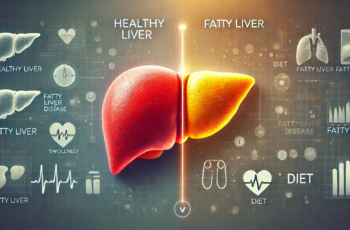Ad Blocker Detected
Our website is made possible by displaying online advertisements to our visitors. Please consider supporting us by disabling your ad blocker.
Hepatitis is a word that might sound clinical and distant, but its reality hits close to home for millions worldwide. It’s not just some abstract “liver condition”—hepatitis, or liver inflammation, can disrupt the body’s rhythm like a bad melody. From viral infections to autoimmune issues and even toxins, this disease wears many disguises, making it tricky to pin down. But what is hepatitis, really, and why does it matter so much? Let’s peel back the layers.
What Is Hepatitis?
Imagine your liver as the body’s bustling command center—detoxifying your system, managing nutrients, and keeping everything running smoothly. Hepatitis throws a wrench into this delicate operation, causing inflammation that can range from mild to catastrophic. The disease can be acute (think of it as a short-term flare-up) or chronic, lingering quietly like a thief in the night.
Among the most talked-about culprits are hepatitis A, B, and C, each with its quirks. Hepatitis A is often tied to contaminated food or water—like that suspicious street food on a humid day—and tends to resolve on its own. Hepatitis B and C, though, are far sneakier, spreading through blood and bodily fluids. These types are more infamous because they can lead to long-term complications if left untreated. And what about hepatitis D and E? Hepatitis D, the troublemaker that piggybacks on hepatitis B, can crank up the severity. Hepatitis E is rarer but often linked to poor sanitation, particularly in certain parts of the world.
So, what hepatitis is the worst? That depends. Hepatitis A might feel like a bad flu, but it rarely leaves lasting damage. Hepatitis B and C, however, can lurk for years, silently increasing the risk of cirrhosis or liver cancer. They’re like hidden landmines—making early detection essential.
Signs and Symptoms of Hepatitis
Recognizing hepatitis isn’t always as simple as spotting a fever or a rash. It’s a chameleon, showing up differently depending on the type and whether it’s acute or chronic.
Take hepatitis A, for instance. What are the hepatitis A symptoms? Picture fatigue that feels like an endless fog, nausea that turns your favorite foods into enemies, and yellowing skin that makes you do a double take in the mirror. These symptoms often come on suddenly and leave just as quickly with proper care.
Now, hepatitis B—what are the symptoms of hepatitis B? This one plays a slower game, sneaking in with dark urine, pale stools, joint aches, and occasional fever. It’s easy to brush off these signs as minor annoyances, which is why it’s often missed early on.
Hepatitis C, on the other hand, is nicknamed “the silent killer” for a reason. It tiptoes through your system with barely a whisper until the damage becomes significant. And when it comes to warning signs of hepatitis C, D, and E, the overlap can be confusing: fatigue, jaundice, digestive discomfort. Chronic cases, particularly hepatitis C and D, can lead to severe liver scarring over time—another reason to stay vigilant.
What Are the Risk Factors for Getting Hepatitis?
Hepatitis doesn’t discriminate, but some people are at higher risk based on lifestyle, environment, and exposure. Who is at risk for hepatitis A, B, C, D, E? The answers vary, and the details are often surprising.
Hepatitis A thrives where hygiene falters—unsanitary water, contaminated food, or close contact with infected individuals. It’s a traveler’s concern in places where sanitation is less reliable. Hepatitis B and C, meanwhile, are most commonly spread through blood and bodily fluids. Sharing needles, unprotected sex, and even childbirth can pass these viruses along.
Hepatitis D? It’s like a tagalong friend you never invited—occurring only in those already infected with hepatitis B. And hepatitis E? That one is often tied to unsafe drinking water, especially in areas without proper sanitation systems.
Healthcare workers, individuals with multiple sexual partners, and people receiving blood transfusions in regions without rigorous screening protocols are all at higher risk. But here’s the catch: even seemingly minor exposures, like sharing a razor, can open the door to infection.
Are There Treatments for Hepatitis?
The good news? Hepatitis isn’t invincible. Treatments exist, tailored to the specific type and severity of the disease.
For hepatitis A and E, the solution is often rest, hydration, and time. These forms usually resolve without chronic complications. Hepatitis B and C, though, require a more aggressive approach. Modern antiviral therapies have revolutionized care, especially for hepatitis C, where direct-acting antivirals (DAAs) have turned what once seemed incurable into a manageable—and often curable—condition. Can hepatitis be cured permanently? With hepatitis C, the answer is a hopeful yes.
Autoimmune hepatitis, a non-viral variant, is a different beast altogether. Its treatment involves taming an overactive immune system with corticosteroids or immunosuppressants. What is autoimmune hepatitis treatment? It’s about striking a delicate balance to prevent the immune system from attacking the liver without leaving the body defenseless.
Advanced cases—where liver damage is extensive—may require a transplant. While this is a last resort, it underscores the urgency of catching and managing hepatitis early.
How to Prevent Getting Hepatitis?
Prevention might sound boring, but it’s your best weapon against hepatitis. Vaccines are available for hepatitis A and B, making them preventable for most people. These shots are lifesavers, literally, by reducing the spread of the virus.
For hepatitis A, hepatitis prevention tips and tricks focus on hygiene: wash your hands religiously, steer clear of sketchy food, and drink only safe, clean water. Hepatitis B and C prevention, meanwhile, revolves around avoiding bloodborne exposures—sterile needles, protected sex, and not sharing personal items like razors or toothbrushes.
For travelers, the advice gets more specific: get vaccinated, drink bottled or boiled water, and avoid raw or undercooked foods. Prevention isn’t glamorous, but it’s practical—and it works.
Share Health and Take Action
Hepatitis doesn’t have to be a shadow lurking in your health story. By staying informed, recognizing the risks, and taking preventive steps, you can protect yourself and those around you. Spread the word—this knowledge might be the lifeline someone else needs.
Disclaimer
This article is for informational purposes only. For diagnosis and treatment tailored to your situation, consult a healthcare professional.



